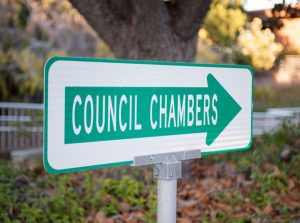Salary and benefit packages topping $400,000 for recent City of Santa Clara hires have raised a few eyebrows around town, with one Santa Clara City Council Member calling them “obscenely generous.”
But what about new hires already collecting a pension from another public pension system in addition to receiving generous compensation packages? Periodically, “double dipping” —receiving public pension payments while collecting a civil service paycheck, sometimes called pension stacking—gets into the news when the practice results in big payouts or involves high profile public officials.
Pennsylvania politico Joe Pitts could be called the poster child for opponents of double dipping. Pitts, a five-term Congressman, collects about $200,000 a year from four public sector pension funds in addition to social security: teaching, military, state legislature and congressional pensions, according to LancasterOnline.com.
Upstate NY district attorney William Fitzpatrick collects an estimated $100,000 pension on top of his $182,000-a-year salary, according to a recent report in the Syracuse Post Standard.
Closer to home, former State Assemblywoman and California State Superintendent of Public Instruction, Delaine Eastin, receives $85,000 from a state pension and $28,000 from Social Security. Eastin is currently running for governor and if elected she would take home another $190,000 a year.
Former Fair Political Practices Commission chairman Ann Ravel collected a $173,000 pension from her 33 years in the Santa Clara County counsel’s office while she was being paid $132,000 as FPPC Chair, according to a 2011 report in LA Observed.
Former San Jose Police Chief William Lansdowne retired in 2003 and went back to work in San Diego, taking home $400,000 a year, according to a 2012 Mercury News report.
The topic became suddenly relevant to Santa Clarans when the City hired a City Attorney who was already collecting a pension from San José.
City Attorney Brian Doyle retired from San José in 2012 and receives $106,000 from the San José pension fund, according to the City of San José, in addition to his $320,000 salary, which includes participation in the CalPERS retirement system. If he stays in Santa Clara for five years he’ll be eligible for about $15,000 a year from CalPERS.
Doyle took an early retirement in 2012 and worked as a private attorney before being hired by Santa Clara in 2017.
“When I was asked to work for the City of Santa Clara four and a half years later, I could not ‘unretire’ from San José and get a reciprocal pension through Santa Clara, so I continue to collect a pension from San José’s pension fund, which is not a CalPERS member,” Doyle said. “I do not have a choice about continuing to collect a pension from San José while I am working for Santa Clara.”
There’s nothing illegal about double dipping. While you can’t collect from CalPERS while working for another CalPERS agency, there’s nothing prohibiting people from collecting a CalPERS pension and working for an agency in a different pension system or vice versa.
Several states have, or plan to, put limits on the practice. This month New Hampshire passed a bill to limit public pensioners working at post-retirement jobs and to penalize employees and employers exceeding those limits. In New York, a waiver is needed to earn more than $30,000 a year in a public job after retiring.
Defenders of the practice say that these hires already know that job and can be productive, faster, and that they don’t cost agencies any more than hiring a new employee. DA Fitzgerald defended his double dipping by saying if he died on the job his wife could continue to collect survivor benefits.
It’s difficult to know how prevalent double-dipping is, explains Stanford Professor of Public Policy Joe Nation, a former California State Assemblyman and Director of Graduate Practicum Stanford Institute for Economic Policy Research (siepr.stanford.edu).
That’s because the data is held in siloed systems without communication among them. Some states, like New Hampshire and New York, have done the homework but so far California has not.
New York State counted 1,830 double dipping pensioners in 2017—out of 623,000 public employees. California has about 885,000 public employees. In 2012 the Mercury News estimated that at least 50 Bay Area public employees are double dipping.
But small numbers don’t mean the practice doesn’t illustrate pervasive problems in the public pension system. “Double dipping hasn’t led to the pension crisis, but it makes people suspicious,” Nation said.
The whole point of relatively low retirement ages for police or firefighters, said Nation, is that these are physically demanding jobs and people aren’t able to do that kind of physical work past 50 or 55. In other words, pensions are supposed to support people when they can’t work—not augment their incomes.
“By setting the retirement age artificially low,” said Nation, “you create the opportunity for mischief. If you build a system where you provide the opportunity to abuse the system, then people will abuse the system.”











0 comments